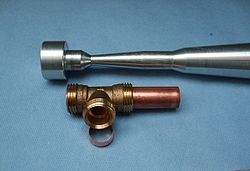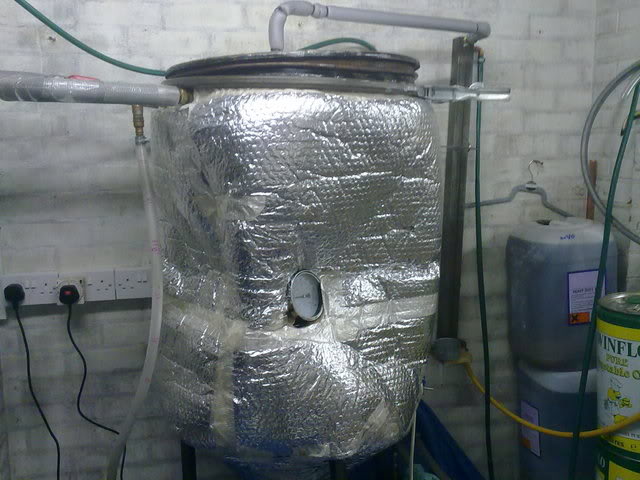Difference between revisions of "Importance of venting a processor"
| Line 19: | Line 19: | ||
==Safety== | ==Safety== | ||
| + | |||
| + | [[File:Collapsed processor 1.jpg]] | ||
Making Biodiesel involves a '''few''' hazardous chemicals. If treated with respect these chemicals can be handled safely by the novice provided a few simple guidelines are followed. There are an increasing number of chemicals being used in home Biodiesel production and all can be employed in the Dr. Pepper method, however as this page is aimed at the novice, we will stick to the least onerous and most widely available. | Making Biodiesel involves a '''few''' hazardous chemicals. If treated with respect these chemicals can be handled safely by the novice provided a few simple guidelines are followed. There are an increasing number of chemicals being used in home Biodiesel production and all can be employed in the Dr. Pepper method, however as this page is aimed at the novice, we will stick to the least onerous and most widely available. | ||
Revision as of 18:29, 30 January 2013
From http://www.vegetableoildiesel.co.uk/forum/viewthread.php?tid=28817
The Dr. Pepper method is so called because it was first carried out in an empty pop bottle previously containing that beverage, and the name’s stuck!
Contents
This is a very simple way of producing a small quantity of Biodiesel where the whole process is visible and provides what is probably the best available demonstration of the process. For this reason it’s used by experienced home brewers to trail different oils or to replicate condition in problem batches. Most importantly it’s probably the best starting point for anyone new to home Biodiesel production.
For the novice, a few successful Dr. Pepper batches instils confidence, demonstrates the exact process without the need for special equipment and offers a good grounding in the basics of Biodiesel production. To keep the process simple this page will detail a Dr. Pepper batch using new cooking oil. This will enable the process to be completed without the complication of titration.
Safety
Making Biodiesel involves a few hazardous chemicals. If treated with respect these chemicals can be handled safely by the novice provided a few simple guidelines are followed. There are an increasing number of chemicals being used in home Biodiesel production and all can be employed in the Dr. Pepper method, however as this page is aimed at the novice, we will stick to the least onerous and most widely available.
Chemicals
Oil … New, liquid vegetable oil, typically rape seed or sunflower oil.
Methanol … available in small quantities from various chemical suppliers and on line auction sites. Methanol is available in various purities. Biodiesel requires Methanol at least 96% pure but preferably 98% which is quite widely available.
Sodium Hydroxide … often referred to as Caustic Soda or lye. This is available from many hardware stores, sold to unblock drains.
Water … available from most taps!
Equipment
An old saucepan. A large pop bottle (we’ll assume 1 litre for the purpose of this page) A measuring jug or some other container marked in millilitres. A stove or hot plate, preferably electric. A thermometer reading to at least 100°C
Safety
Method
Testing
Quoted text here.
heading
heading b
heading
| Standard Cylinders | |||||
|---|---|---|---|---|---|
| British standard |
External diameter of cylinder (excluding insulation) |
External height over dome |
Min storage capacity | Expected port fittings | |
| Direct | Indirect | ||||
| mm | mm | Litres | Litres | female, BSP | |
| 0 | 300 | 1600 | 98 | 96 | 1" |
| 1 | 350 | 900 | 74 | 72 | 1" |
| 2 | 400 | 900 | 98 | 96 | 1" |
| 3 | 400 | 1050 | 116 | 114 | 1" |
| 4 | 450 | 675 | 86 | 84 | 1" |
| 5 | 450 | 750 | 98 | 95 | 1" |
| 6 | 450 | 825 | 109 | 106 | 1" |
| 7 | 450 | 900 | 120 | 117 | 1" |
| 8 | 450 | 1050 | 144 | 140 | 1 1/4" |
| 9 | 450 | 1200 | 166 | 162 | 1 1/4" |
| 9e | 450 | 1500 | 210 | 206 | 1 1/4" |
| 10 | 500 | 1200 | 200 | 190 | 1 1/2" |
| 11 | 500 | 1500 | 255 | 245 | 1 1/2" |
| 12 | 600 | 1200 | 290 | 280 | 2" |
| 13 | 600 | 1500 | 370 | 360 | 2" |
| 14 | 600 | 1800 | 450 | 440 | 2" |

